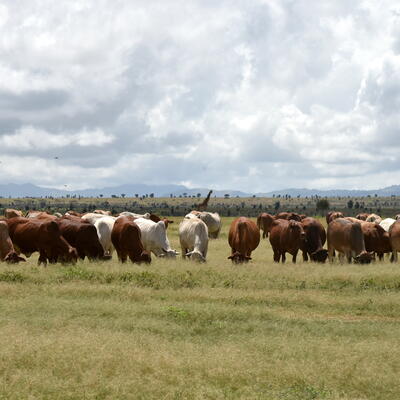

Wildlife-livestock interface research
The wildlife-livestock interface serves as an integral ecosystem to the livelihoods of local communities. It supports biodiversity, which provides carbon sinks that reduce greenhouse gas emissions and enhance community livelihoods. Wild animals appear to be involved in the epidemiology of most zoonoses and serve as major reservoirs for zoonotic spillover—the transmission of zoonotic pathogens to domestic animals and humans. Improved livelihoods can lead to better management practices that protect and conserve biodiversity.
The International Livestock Research Institute (ILRI) has led a rich legacy of human-livestock-wildlife coexistence work, carried out mainly by scientists in the early 1980s.
The four focus areas of ILRI’s One Health strategy map wildlife-interface activities. The focus areas are:
- Pandemics, epidemics and disease outbreaks
- Neglected endemic zoonoses
- Foodborne diseases
- Antimicrobial resistance
The human-livestock-wildlife-environment interface provides the biological, ecological and epidemiological conditions for pathogen spillover through increased interactions with wildlife.
ILRI’s wildlife research activities, which focus on health risks, can be broadly categorized into three areas:
- Wildlife-livestock-environment interface
- Human-wildlife-environment interface
- Wildlife value chain activities, including wild meat slaughter and consumption and wildlife farming
Research aims to understand the health risks at the human-livestock-wildlife-environment interface and provide mitigating solutions.
ILRI’s commitment in 2020 to wildlife research and species conservation has enabled its researchers to increase engagement with different sectors including ministries, local and national governments, conservation groups, research institutions and universities.
This web page highlights wildlife research activities by ILRI and partners.
Related news

ILRI scientists and research collaborators use a One Health approach to study zoonotic disease risks in wildlife farming in Vietnam

Scientists test an experimental vaccine against malignant catarrhal fever at ILRI’s Kapiti Research Station

ILRI News
New study assesses disease risk perceptions of wild meat at the border of Kenya and Tanzania
Related projects
Publications

An operational framework for wildlife health in the One Health approach
- Goulet, C.
- Garine-Wichatitsky, M. de
- Chardonnet, P.
- Klerk, L.-M. de
- Kock, R.
- Muset, S.
- Suu-Ire, R.
- Caron, Alexandre

Assessing disease risk perceptions of wild meat in savanna borderland settlements in Kenya and Tanzania
- Patel, Ekta
- Martin, A.
- Funk, S.M.
- Yongo, M.
- Floros, C.
- Thomson, J.
- Fa, J.E.

Eating wild animals: Rewards, risks and recommendations
- Grace, Delia
- Bett, Bernard K.
- Cook, Elizabeth A.J.
- Lam, Steven
- MacMillan, Susan
- Masudi, Phyllis
- Mispiratceguy, M.
- Ha Thi Thanh Nguyen
- Hung Nguyen-Viet
- Patel, Ekta
- Slater, Annabel
- Staal, Steven J.
- Thomas, Lian F.

Molecular detection of Cryptosporidium species in wildlife and humans at the wildlife-human interface around Queen Elizabeth National Park, Uganda
- Mugasa, C.M.
- Mirembe, B.B.
- Ochwo, S.
- Nkamwesiga, Joseph
- Ndekezi, C.
- Tusabe, T.
- Musoba, A.
- Kankya, C.





























